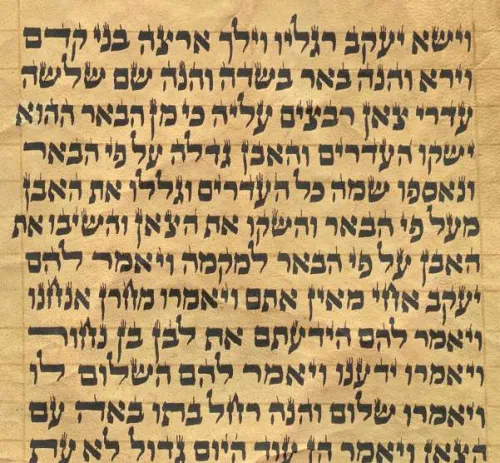Part ll: Hebrew Scriptures
Known to Christians as the "Old Testament," the 39 books of Hebrew Scripture have been carefully copied and passed down through the centuries. From the very beginning, these writings were recognized as divinely inspired, with each author guided by God in selecting what to record. While the original writings were perfect, ensuring accuracy as they were copied over generations became the responsibility of dedicated scribes. They took this task incredibly seriously, knowing that preserving God’s Word required both precision and reverence.
The preservation process began with the first five books—the Torah—when Moses commanded that they be kept in the Holy of Holies:
"And it came to pass, when Moses had made an end of writing the words of this law in a book, until they were finished, that Moses commanded the Levites, which bare the ark of the covenant of the Lord, saying, 'Take this book of the Law, and put it in the side of the ark of the covenant of the Lord your God, that it may be there for a witness against thee.'" (Deuteronomy 31:26)
Though God did not promise that every single copy made over the centuries would be flawless, history shows His divine hand at work in protecting His Word. The incredible accuracy of the Hebrew Scriptures is largely due to the devotion of Jewish scribes, known as soferim. These men were not just skilled in calligraphy; they followed strict traditions and guidelines to ensure that no errors crept into the text.

The Scribes’ Process: A Sacred Duty
Even today, some soferim continue the ancient practice of copying the Scriptures by hand, just as their ancestors did for thousands of years. Jewish law, recorded in the Talmud, outlines precise instructions for this process. The Hebrew text had to be written in a specific script, called K’tav Ashuri, similar to how an English book might be required to use a specific font like Times New Roman instead of cursive. This ensured consistency and eliminated the risk of misinterpretation.
But the rules didn’t stop there. Every aspect of the writing process was deeply intentional:
- Materials: Scribes could only write on parchment made from clean animal skins (vellum or parchment), which were meticulously prepared through soaking, stretching, and scraping. The ink also had to be specially made—free from metals like iron or steel, which were associated with weapons and war. Instead, scribes used tools crafted from gold, silver, or ivory.
- Spiritual Preparation: Copying the Torah was seen as a sacred act (mitzvah). Scribes prayed before beginning their work, washed their hands before each session, and even spoke or sang each word aloud as they wrote.
- Respect for God’s Name: Before writing “Jehovah” (YHWH), scribes had to wash their entire bodies in a ritual bath (mikveh) and clean their pens, emphasizing the holiness of God's name.
Extreme Measures to Prevent Errors
Scribes took incredible precautions to ensure that no mistakes slipped into the sacred text:
- No Guesswork Allowed: Even though most scribes had the Torah memorized, they weren’t allowed to write a single word from memory. They had to copy directly from a “tikkun,” a master text passed down from earlier generations.
- Counting Every Letter: After finishing a page, scribes counted every letter, word, and paragraph, ensuring that the new copy matched the original exactly.
- Strict Error Policies: If a single mistake was found, the entire page had to be rewritten. If multiple pages had errors, the entire scroll was discarded!
Once a Torah scroll was complete, it was checked by three rabbis before being sewn together into a full-length scroll—often stretching up to 100 yards when unrolled! Even after passing all these checks, the scroll was reviewed again within 30 days.
What Happened to Old Scrolls?
Because faded or smudged letters could lead to errors in future copies, old or worn-out scrolls were no longer used. However, since Jews believed that God’s Word should never be destroyed, these scrolls weren’t thrown away. Instead, they were stored in a special hiding place called a genizah, often within a synagogue or cemetery.
The Dead Sea Scrolls: A Stunning Confirmation
With so many copies being made over thousands of years, a big question remained: Were the scribes truly accurate? Had errors crept into the Old Testament over the centuries?
The answer came in 1947 when a young shepherd, exploring caves near the Dead Sea, made one of the greatest archaeological discoveries of all time—the Dead Sea Scrolls. These ancient Hebrew manuscripts, dating back over 2,000 years, contained large portions of the Old Testament. When scholars compared them to modern versions of the Hebrew Scriptures, they found astonishing accuracy, proving that the scribes’ meticulous methods had successfully preserved God’s Word through the ages.
A Lasting Legacy
For generations, Jewish scribes balanced two crucial responsibilities: preserving the text of Scripture with absolute precision while ensuring its widespread distribution. Their unwavering dedication made it possible for God’s Word to reach people across the world while remaining true to its original form. Today, whether read in Hebrew, English, or any other language, the Bible stands as a testament to both human faithfulness and divine preservation.
